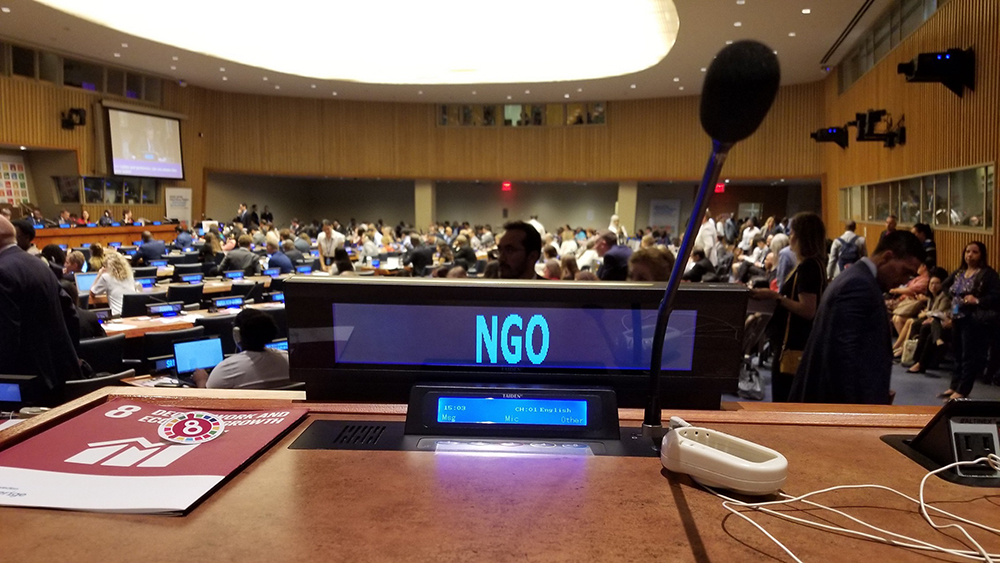This piece was submitted from a member of our enthusiastic community of readers. If you’re interested in sharing your opinion on any cultural, political or personal topic, create an account here and check out our how-to post to learn more.
Last month, members of the global community came together at the United Nations in New York to provide an update on the progress of the Sustainable Development Goals. The 17 goals were adopted in 2015 by the 193 member states to address everything from poverty to human trafficking and climate change. For 10 days, the UN was abuzz at the High Level Political Forum with delegates from Member States, NGOs, as well as members of civil society all weighing in on the world's progress from their respective vantage points. Yet, it wasn't who was in the room that made the most striking statement to those who are affected by SDG policy. What stood out was who was not in the room in meaningful numbers. NGO delegates from the United States were hard pressed to find an ally in the room who was committed to accomplishing the goals on the ground in the U.S.
The United States is not completely silent on the Sustainable Development Goals, but talk of the lofty goals to create a more humane world are little more than a whisper above the noise of campaigns, congressional hearings and questions of espionage.
There is an official page on the U.S. government's website that lists the 17 goals and reflects a green bar where the objectives of the goal are being reported and a red bar where the government is still "exploring data sources." Of the 244 indicators in the 17 goals, the United States is self-reporting on just under half at 41%. But what have we learned and even more what have we accomplished? Goal 4, "Ensure inclusive and equitable quality education and promote lifelong learning opportunities for all," is reporting on 100% of its 11 indicators. However, a closer look at the information provided on the site in response to Indicator 4.6.1: "Proportion of population in a given age group achieving at least a fixed level of proficiency…" reflects the answer is a simple "48" — in 2012. There is a lot to unpack in that statistic on the leader of the free world, but it won't be found on the government's site.
How does community engagement factor in the accomplishment of the Sustainable Development Goals? The lead non-governmental organization in the country is SDGUSA, headed by Jeffrey D. Sachs. According to his bio Mr. Sachs is called by the New York Times, “probably the most important economist in the world,” and by Time Magazine “the world’s best known economists." His organization sees as its mission to "adapt the UN’s Sustainable Development Goals to the U.S. context and encourages all citizens, businesses, civil society organizations and governments at all levels to promote America’s Goals for 2030." On what isolationist planet the US would find it necessary to reorganize the 17 goals into its it's own set of standards is a mystery to the non-important, unknown, nom-economists, but as a recent viral meme said, "it's above us now". What is not clear is the strategy that this team of academics, project managers and other high achieving people plan to employ to reach the rest of the United States.
And where is the media? Since the 2015 announcement of the SDGs, the relative silence on the SDGs has been deafening. Save for a Forbes article on Ghana's plans fo finance the SDGs in that country and Yale's announcement of its own report in its own article, the UN High Level Political Forum would have gone completely unnoticed in the U.S.
Perhaps the Academy thinks we're not smart enough and the media thinks it's not sensational enough for us to care about things like, hunger, reduced inequalities, clean water, healthy oceans or peace and justice. Perhaps our leaders are more concerned with winning elections to get bogged down with such mundane matters as gender equality and poverty. Perhaps the United States believes that we are unlike the rest of the world and are too distinctive to align ourselves with a global context. Maybe we should ask the other 52% of the U.S. population that has not reached a fixed level of proficiency. After all, we haven't checked on them in seven years.
